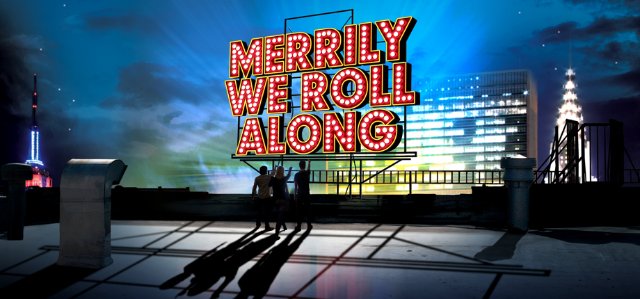Merrily We Roll Along
New York Theater Workshop
By: Karen Isaacs - Jan 21, 2023
How did I/he/she end up here? It’s a question we all ponder and which Merrily We Roll Along uses as the premise.
We meet the characters in their 40s and then slowly see how decisions they made from their 20s on led to those places.
The revival of the Sondheim/Furth musical makes a strong case for the show, which was initially a flop. The lovely score has led to multiple directors and performers trying to solve the so-called problems with the show.
The New York Theater Workshop production – which will head to Broadway this year – may not solve all the issues, but strong performances make it a show worth seeing.
The show opens on an ‘80s-style Hollywood party thrown by Franklin Shepherd (Jonathan Groff) celebrating the successful opening of his most recent film production. His wife, Gussie (Krystal Joy Brown) is there, as is his leading lady (and latest squeeze) and Mary, a writer who has been a friend since they were both in their early twenties.
He may be successful and good-looking, but he seems lost and hollow. How did he get there? How did Mary become the embittered drunk? And why is the name of playwright Charlie Kringas off-limits?
We discover how these three close friends and collaborators became whom we see at the opening. The show ends with them in their very early 20s, in New York City, struggling with part-time jobs, unfulfilling gigs and endless optimism that they will “make it.”
One of the reasons this production has gotten so much attention is that Daniel Radcliffe plays Charlie. People may know him as Harry Potter, but Radcliffe is both a terrific stage actor and musical performer.
But the show needs more than just Ratcliffe to work; this production directed by Maria Friedman has it. Friedman directed the 2012 award-winning production of the musical in London, which I saw; she also performed as Mary in a 1992 production.
She has an outstanding cast to work with in addition to Radcliffe: Tony winner Lindsay Mendez as Mary and Jonathan Groff as Franklin plus Brown as Gussie, Katie Rose Clarke as Shepherd’s first wife, and Reg Rogers as Gussie’s first husband.
The opening is brilliant, setting the mood and the character of Franklin. As the cast sings the opening number, Franklin walks on stage – observing but not engaged.
First of all, the music. It contains some of Sondheim’s most classic numbers: “Old Friends,” ‘Not a Day Goes By,” “Good Thing Going,” “Our Time” and more. Even the very show-specific song, “Franklin Shepherd, Inc” is familiar to many.
The role of Mary is complex; she too is emotionally stalled by her unrequited love for Franklin. In fact, Franklin is totally oblivious to the obvious signs that she gives off throughout the show. Lindsay Mendez brings a vulnerability to the role without ever overdoing it. I wanted to stand up a shout at Franklin – “don’t you see, she loves you!” But she is also stalled in other ways. After writing one wildly successful book she cannot seem to finish another.
Charley is the most grounded of the three friends, though there is still an undertone of bitterness and anger. After all, he and Franklin had the makings of a top-flight musical theater creative team. We don’t even meet Charley until the second scene, set in 1973, and the infamous TV interview that breaks up the partnership. Radcliffe gives a bravura rendition of “Franklin Shepherd, Inc.” that accuses Shepherd of being more interested in making money than in making art. He slowly builds the number until his anger comes spilling out.
Groff doesn’t try to sugarcoat Franklin or make him likable. He really isn’t. We can understand him and perhaps even have some concern for him, but we don’t like him. Though Franklin may be the central figure, he does not have any solo numbers; all are with others – Gussie (“Growing Up”), Charley (“Good Thing Going”), or Mary & Charley (“Old Friends”).
The scenic design by Soutra Gilmour introduces us to a bland setting – it can be a 1970s contemporary California home or a cramped apartment. Perhaps when the show moves to Broadway (sometime in 2023), it will be evolved to more specificity. But somehow it works as it is – the bland colors seem as hollow as some of the characters. Gilmour also did the costume design which must move from Hollywood glamour of the ‘80s to struggling artists in 1959. It works.
Look for this production to come to Broadway and finally redeem the show. Merrily We Roll Along isn’t a great musical, but in reality, it is more interesting than many of the long-running “hits.”

